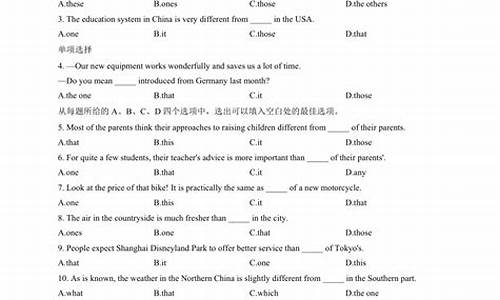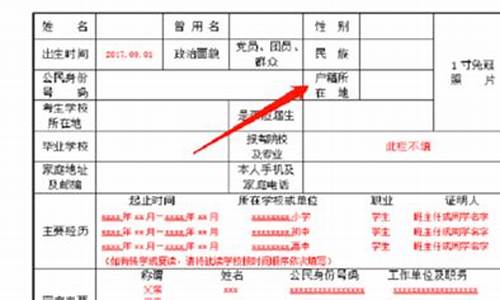您现在的位置是: 首页 > 教育分析 教育分析
高考代词训练_高考英语代词知识点归纳
tamoadmin 2024-05-21 人已围观
简介1.高考英语语法:反身代词的句法功能随着超女和快男在全国各地如火如荼地展开,我们熟悉的人称代词现在也站在舞台上了呢!来听听它们说什么吧:No1我们的分类我们人称代词分为主格和宾格。具体如下:主格有八个: I,you(你),_____,she,it,_____,you(你们),_____。宾格也有八个:_____,you(你),him,_____,it,us,_____(你们),them。[答案揭秘
1.高考英语语法:反身代词的句法功能

随着超女和快男在全国各地如火如荼地展开,我们熟悉的人称代词现在也站在舞台上了呢!来听听它们说什么吧:
No1我们的分类
我们人称代词分为主格和宾格。具体如下:
主格有八个: I,you(你),_____,she,it,_____,you(你们),_____。
宾格也有八个:_____,you(你),him,_____,it,us,_____(你们),them。
[答案揭秘] he,we,they,me,her,you。
No2我们的用法
“句子主语用主格,动、介词后接宾格”,听说过吗?这便是我们的用法了!来给你们解释一下吧:
主格:在句子中只能作主语,通常放在句子开头,即谓语动词的前面。主格常常与谓语动词在人称和数等方面保持一致。如:
She was at school yesterday. 她昨天在学校里。
They all like listening to Mr. Guo’s English class. 他们都喜欢听郭老师的英语课。
宾格:在句子中常常作宾语,偶尔也作表语,具体用在:
1) 及物动词的后面
用在及物动词give, pass, take, buy, tell, like等词的后面,作宾语。如:
My father often tells me some interesting stories. 爸爸经常给我讲一些有趣的故事。
Mum, can you take us to the Congtai Park tomorrow?
妈妈,明天你能带我们去丛台公园吗?
2) 介词的后面
介词不单独使用,其后面常常接宾语,那么,宾格就常常用在介词:in, on, under, to, at, behind, between, for, of 等词的后面。如:
What about them? 他们怎么样?
You must look after her. 你必须照顾她。
3) 作表语。如:
-Who's it? 是谁呀?
-It's me. 是我。
特别提醒人称代词,不论是主格还是宾格,一旦并列,排列的口诀方法是:
人称代词肩并肩,排列顺序要过关。单数人称二三一,复数人称一二三。
I 词出现放后边,表示礼貌译在前。要是没理来道歉,承担责任I在前。
高考英语语法:反身代词的句法功能
一、 关系代词和关系副词的区别
1、关系代词(that, who, whom, whose, which)所代替的先行词是人或物的名词或代词,并在句中充当主语、宾语、定语等成分。
例1. Is he the man who/that wants to see you?(who / that在从句中作主语,指人)
例2. He is the man whom/ that I saw yesterday.(whom / that在从句中作宾语,指人)
例3. They rushed over to help the man whose car had broken down.(whose在句中作定语,指人)
例4. Please pass me the book whose (of which) cover is green.(whose在句中作定语,指物。若指物,它还可以同of which互换)
例5. The package (which / that) you are carrying is about to come unwrapped. 你拿的包快散了。(which / that在句中作carry的宾语,指物)
2、关系副词(when, where, why, that)可代替的先行词是时间、地点或理由的名词,在从句中作状语。关系副词when, where, why的含义相当于"介词+ which"结构,因此常常和"介词+ which"结构交替使用。
例6. Beijing is the place where (in which) I was born.
例7. Is this the reason why (for which) he refused our offer?
例8. His father died the year (that / when / in which) he was born.
例9. He can’t find the place (that / where / in which) he lived forty years ago.
二、 判断用关系代词和关系副词
方法1: 用关系代词,还是关系副词完全取决于从句中的谓语动词。及物动词后面无宾语,就必须要求用关系代词;而不及物动词则要求用关系副词。请改错:
1. This is the mountain village where I visited last year.
2. I will never forget the days when I spent in the countryside.
习惯上总把表地点或时间的名词与关系副词 where, when联系在一起。此两题错在关系词的误用上。句1和句2的where, when都应改为which.。
方法2: 准确判断先行词在定语从句中的成分(主、谓、宾、定、状),根据第一点(区别),也能正确选择出关系代词/关系副词。
例10.This museum is ___ you visited a few days age?
A. where B. that C. on which D. the one
例11. This is the museum ____ the exhibition was held.
A. where B. that C. on which D. the one (答案:例1 D,例2 A)
在例10中,所缺部分为宾语,而where, that, on which都不能起到宾语的作用,只有the one既做了主句的表语,又可做从句的宾语,可以省略关系代词,所以应选D。
而例11中, 主、谓、宾俱全,从句部分为句子的状语表地点,既可用副词where,又因 in the museum词组,可用介词in + which 引导地点状语。而此题中,介词on 用的不对,所以选A。
关系词的选择依据在从句中所做的成分,先行词在从句中做主、定、宾语时,选择关系代词 (who, whom, that, which, whose); 先行词在从句中做状语时,应选择关系副词 ( where 地点状语,when 时间状语,why 原因状语)。
方法3:当先行词是all, everything, anything, nothing,the one, much, few, any, little等,或先行词是形容词级时,或在there be 句型中,或当先行行词既有人又有物时,关系代词用that, 而不用which。
例12. Finally, the thief handed everything that he had stolen to the police.
例13. The soldiers and their guns that we sent to the front were lost.
方法4:在引导非限定性定语从句时,和在介词后不能用that,应用which。
例14.(错) The tree, that (改为which)is four hundred years old, is very famous here.
例15.We depend on the land from which we get our food.
高考英语语法:反身代词的句法功能
1. 用作同位语(加强被修饰词的语气,紧放在被修饰名词后, 或句末)。如:
The box itself is not so heavy. 箱子本身并不重。
You yourself said so. / You said so yourself. 你自己是这样说的。
2. 用作宾语(动词或介词的宾语)。如:
Take good care of yourself. 照顾好自己。
She could not make herself understood. 她不能使别人听懂她的话。
3. 用作表语。如:
The poor boy was myself. 那个可怜的孩子就是我自己。
The ones who really want it are ourselves. 真正想要它的是我们自己。
有时用于 be, feel, seem, look 等后作表语表示身体或精神处于正常状态。如:
I’m not quite myself these days. 我近来身体不大舒服。
I’ll be myself again in no time. 我过一会儿就会好的。
4. 用作主语。在现代英语中,反身代词一般不能独立用作主语,但是它却可以借助 and, or, nor 等连词与其他名词一起构成并列主语(且位于并列主语的后部),以及用于某些特殊结构(如as...as等)。如:
My brother and myself went there yesterday. 昨天我兄弟和我一起去了那儿。
Jim’s sister and himself get up at six every day. 吉姆的妹妹和他每天6点起床。
He was as anxious as myself. 他和我一样担心。
上一篇:惠州高考报名时间,惠州高考考生









